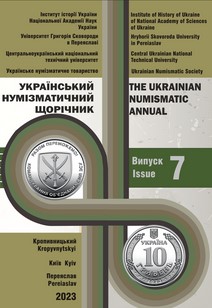ШТЕМПЕЛЬНИЙ АНАЛІЗ: СУЧАСНИЙ СТАН ЗАСТОСУВАННЯ ТА ПЕРСПЕКТИВИ ЦИФРОВІЗАЦІЇ МЕТОДУ
DIE ANALYSIS: CURRENT STATE OF APPLICATION AND PROSPECTS OF DIGITALIZATION OF THE METHOD
Author(s): Olena ShvetsSubject(s): Economic history, Methodology and research technology, ICT Information and Communications Technologies
Published by: ДВНЗ Переяслав-Хмельницький державний педагогічний університет імені Григорія Сковороди
Keywords: numismatics; coin; coin die; digital numismatics; digitization; digitalization; dies analysis;
Summary/Abstract: The Problem Statement. The study of coin die is one of the main methods used to study the fundamental components of numismatic science – the history of money circulation and the history of coinage. During the production process of any coin, an imprint of dies (stamps) is stored on it, which were always produced in pairs (upper and lower). On their working surface, a negative image of the obverse and reverse of the future coin is engraved, in particular, portraits of the rulers of the state, coats of arms and other elements that are not just decorative, but carry information about such «official» parts of the history of a certain state as local religion , economic policy, power ambitions, social self-identity and other aspects of the history of ancient space. Based on this, it is worth noting that a detailed study of each existing ancient coin helps us to make a general picture of the fiscal and monetary policy of the state, as well as to understand how mints and state institutions worked, how their structure and production processes were organized. A comprehensive study of coinage reveals a great deal of evidence, particularly in economic history, and is used for a deeper understanding of it. The Aim of Articleis to research and highlight the process of modernization and digitalization of the method of comparative die analysis, which is actively used by scientists during numismatic research, and to consider the current state of this direction and its development prospects. Scientific novelty. The first coins in the world appeared in ancient times, and the first mentions of the beginning of conscious collecting and the appearance of numismatists are known to us from the 14th–15th centuries. Coin collecting was the first step towards the emergence of numismatics as a scientific field, the beginning of which can be attributed to the 18th century, when the Austrian priest and numismatist Joseph Eckel created the foundations and principles of systematization of individual coin specimens according to the historical and geographical principle. It was this event that became a major impetus for the development of numismatics as a scientific discipline, whose representatives began a detailed study of coins for a deeper understanding of the history, culture and economy of the world. Over time, this discipline gained expressiveness, due to which its clear directions, tasks and methods were formed. One such basic method is the analysis of coin dies and their comparison, and like any scientific method it must evolve and move in step with technological progress, meeting the needs and demands of modern scholars. That is why the study of the current state and development of this method deserves special attention, in order to improve the quality of the results obtained and the possibility of saving the precious time of each researcher. The main results of the research. Our research analyzed the positive impact of digital technologies on scientific methods in numismatics. The current methods of postmark analysis using modern software and attempts to use neural networks for comparative analysis of coin dies were also considered. The results of the study testify to the colossal evolution of the postmark analysis method over the past 20 years, and confirm that digitization is a key factor in the development of any scientific research. It improves the existing methods, opening new ways for scientists to conduct numismatic research, and provides new opportunities for solving complex tasks, which promotes innovation and progress in the scientific field, saves time and improves the quality of the results obtained in the process.
Journal: Український Нумізматичний Щорічник
- Issue Year: 2023
- Issue No: 7
- Page Range: 288-306
- Page Count: 19
- Language: Ukrainian

